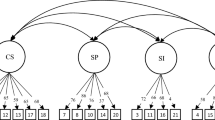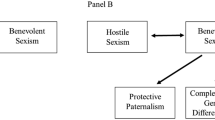Abstract
Previous measures of erotophobia/erotophilia like the Sexual Opinion Survey (SOS) assessed gut-level positive–negative affective and evaluative reactions to a wide range of sexual stimuli, resulting in purposefully diverse item content. Although an effective strategy, the item content of existing erotophilia/erotophobia scales is now potentially too generalized, encompassing what have since developed as an array of more focused constructs in the current literature like attitudes toward (1) casual sex, (2) pornography, (3) non-heterosexual orientations (e.g., homophobia), and (4) masturbation. The current study therefore sought to evaluate existing scales and to develop a conceptually focused measure of sex-positivity and sex-negativity using a distinct strategy designed to obviate the need for overly generalized (and potentially imbalanced or confounding) item content. Using responses from 2205 online respondents (82% Caucasian, 66% heterosexual, and 50% female) completing an item pool of 158 items, the current study employed a combination of classic test-theory analyses (e.g., exploratory and confirmatory factor analyses) and item response theory analyses to develop a psychometrically optimized scale—the Sex Positivity–Negativity (SPN) scale. The SPN scale demonstrated: (1) a stable 2-subscale structure distinguishing sex-negativity from sex-positivity, (2) consistently high levels of internal consistency across 31 demographic subsamples, (3) more discriminant than convergent validity with existing erotophilia scales given its novel focus, (4) discriminant validity with more specific sexual attitudes, (5) greater levels of power and precision for detecting differences between individuals, (6) stronger links to individual, sexual, and relationship functioning than existing scales, and (7) incremental validity over the SOS for predicting change in relationship dynamics over 6 months. The findings therefore suggested that the SPN scale is a conceptually focused measure of sex-positivity and sex-negativity offering researchers a comparatively short and effective tool. Implications are discussed.



Similar content being viewed by others
Availability of data and material
The authors have made the syntax and study materials freely available on the open science framework at: https://osf.io/fc72h/. A de-identified version of the data set is also stored under that project in osf.io and will be made available upon request.
References
Arcos-Romero, A. I., Moyano, N., & Sierra, J. C. (2018). Psychometric properties of the Orgasm Rating Scale in context of sexual relationship in a Spanish sample. Journal of Sexual Medicine, 15, 741–749. https://doi.org/10.1016/j.jsxm.2018.03.005
Balzarini, R. N., Shumlich, E. J., Kohut, T., & Campbell, L. (2018). Sexual attitudes, erotophobia, and sociosexual orientation differ based on relationship orientation. Journal of Sex Research. https://doi.org/10.1080/00224499.2018.1523360
Bogaert, A. F. (2001). Personality, individual differences, and preferences for the sexual medial. Archives of Sexual Behavior, 30, 29–53. https://doi.org/10.1023/a:1026416723291
Bogaert, A. F., & Fisher, W. A. (1995). Predictors of university men’s number of sexual partners. Journal of Sex Research, 32, 119–130. https://doi.org/10.1080/00224499509551782
Buunk, B. (2011). The Anticipated Sexual Jealousy Scale. In T. D. Fisher, C. M. Davis, W. L. Yarber, & S. L. Davis (Eds.), Handbook of sexuality-related measures (3rd ed., pp. 460–461). Routledge.
Evans-Decicco, J. A., & Cowan, G. (2001). Attitudes toward pornography and the characteristics attributed to pornography actors. Sex Roles, 44, 351–361. https://doi.org/10.1023/A:1010985817751
Fabrigar, L. R., Wegener, D. T., MacCallum, R. C., & Strahan, E. J. (1999). Evaluating the use of exploratory factor analysis in psychological research. Psychological Methods, 4, 272–299. https://doi.org/10.1037/1082-989X.4.3.272
Fallis, E. E., Gordon, C., & Purdon, C. (2011). Sexual Anxiety Scale. In T. D. Fisher, C. M. Davis, W. L. Yarber, & S. L. Davis (Eds.), Handbook of sexuality-related measures (3rd ed., pp. 228–231). Routledge.
Fisher, W. A. (1998). The Sexual Opinion Survey. In C. M. Davis, W. L. Yarber, R. Bauserman, G. Scheer, & S. L. Davis (Eds.), Handbook of sexuality-related measures (pp. 218–223). Sage Publications, Inc.
Fisher, W. A., Donahue, K. L., Long, J. S., Heiman, J. R., Rosen, R. C., & Sand, M. S. (2015). Individual and partner correlates of sexual satisfaction and relationship happiness in midlife couples: Dyadic analysis of the international survey of relationships. Archives of Sexual Behavior, 44, 1609–1620. https://doi.org/10.1007/s10508-014-0426-8
Fisher, W. A., Grenier, G., Watters, W. W., Lamont, J., Cohen, M., & Askwith, J. (1988a). Students’ sexual knowledge, attitudes toward sex, and willingness to treat sexual concerns. Academic Medicine, 63, 379–385. https://doi.org/10.1097/00001888-198805000-00005
Fisher, W. A., Miller, C. T., Byrne, D., & White, L. A. (1980). Talking dirty: Responses to communicating a sexual message as a function of situational and personality factors. Basic and Applied Social Psychology, 1, 115–126. https://doi.org/10.1207/s15324834basp0102_2
Fisher, W. A., White, L. A., Byrne, D., & Kelley, K. (1988b). Erotophobia–erotophilia as a dimension of personality. Journal of Sex Research, 25, 123–151. https://doi.org/10.1080/00224498809551448
Fraley, R. C., Waller, N. G., & Brennan, K. A. (2000). An item response theory analysis of self-report measures of adult attachment. Journal of Personality and Social Psychology, 78, 350–365. https://doi.org/10.1037/0022-3514.78.2.350
Funk, J. L., & Rogge, R. D. (2007). Testing the ruler with item response theory: Increasing precision of measurement for relationship satisfaction with the Couples Satisfaction Index. Journal of Family Psychology, 21, 572–583. https://doi.org/10.1037/0893-3200.21.4.572
Geer, J. H., & Robertson, G. G. (2005). Implicit attitudes in sexuality: Gender differences. Archives of Sexual Behavior, 34, 671–677. https://doi.org/10.1007/s10508-005-7923-8
Hambleton, R. K., Swaminathan, H., & Rogers, H. J. (1991). Fundamentals of item response theory. Sage.
Hangen, F., Crasta, D., & Rogge, R. D. (2020). Delineating the boundaries between nonmonogamy and infidelity: Bringing consent back into definitions of consensual nonmonogamy with latent profile analysis. Journal of Sex Research, 57(4), 438–457.
Hays, R., & DiMatteo, M. R. (1987). A short-form measure of loneliness. Journal of Personality Assessment, 51, 69–81. https://doi.org/10.1207/s15327752jpa5101_6
Herek, G. (1998). Attitudes toward lesbians and gay men scale. In C. M. Davis, W. L. Yarber, R. Bauserman, G. Scheer, & S. L. Davis (Eds.), Handbook of sexuality-related measures (pp. 392–393). Sage Publications, Inc.
Hurlbert, D. F., Apt, C., & Rabehl, S. M. (1993). Key variables to understanding female sexual satisfaction: An examination of women in nondistressed marriages. Journal of Sex and Marital Therapy, 19, 154–165. https://doi.org/10.1080/00926239308404899
John, O. P., Naumann, L. P., & Soto, C. J. (2008). Paradigm shift to the integrative Big-Five trait taxonomy: History, measurement, and conceptual issues. In O. P. John, R. W. Robins, & L. A. Pervin (Eds.), Handbook of personality: Theory and research (pp. 114–158). Guilford Press.
Kalichman, S. C., & Rompa, D. (1995). Sexual sensation seeking and sexual compulsivity scales: Reliability, validity, and predicting HIV risk behavior. Journal of Personality Assessment, 65, 586–601. https://doi.org/10.1207/s15327752jpa6503_16
Labranche, E. R., Helweg-Larsen, M., Byrd, C. E., & Choquette, R. A. (1997). To picture or not to picture: Levels of erotophobia and breast self-examination brochure techniques 1. Journal of Applied Social Psychology, 27(24), 2200–2212.
Levin, L., & Peled, E. (2011). The attitudes toward prostitutes and prostitution scale: A new tool for measuring public attitudes toward prostitutes and prostitution. Research on Social Work Practice, 21, 582–593. https://doi.org/10.1177/1049731511406451
Lippa, R. A. (2006). Is high sex drive associated with increased sexual attraction to both sexes? Psychological Science, 17, 46–52.
Luchetta, T., & Pardie, P. (Eds.). (1999). The construction of attitudes toward lesbians and gay men (1st ed.). Routledge. https://doi.org/10.4324/9781315809595
Maniaci, M. R., & Rogge, R. D. (2014). Caring about carelessness: Participant inattention and its effects on research. Journal of Research in Personality, 48, 61–83. https://doi.org/10.1016/j.jrp.2013.09.008
Meltzer, A. L., Makhanova, A., Hicks, L. L., French, J. E., McNulty, J. K., & Bradbury, T. N. (2017). Quantifying the sexual afterglow: The lingering benefits of sex and their implications for pair-bonded relationships. Psychological Science, 28, 587–598. https://doi.org/10.1177/0956797617691361
Meng, X.-L., Rosenthal, R., & Rubin, D. B. (1992). Comparing correlated correlation coefficients. Psychological Bulletin, 111, 172–175.
Osgood, C. E. (1964). Semantic difmential technique in the comparative study of cultures 1. American Anthropologist, 66, 171–200. https://doi.org/10.1525/aa.1964.66.3.02a00880
Papp, L. M., Goeke-Morey, M. C., & Cummings, E. M. (2013). Let’s talk about sex: A diary investigation of couples’ intimacy conflicts in the home. Couple and Family Psychology: Research and Practice, 2, 60–72. https://doi.org/10.1037/a0031465
Penke, L., & Asendorpf, J. B. (2008). Beyond global sociosexual orientations: A more differentiated look at sociosexuality and its effects on courtship and romantic relationships. Journal of Personality and Social Psychology, 95, 1113–1135. https://doi.org/10.1037/0022-3514.95.5.1113
Rogge, R. D., Fincham, F. D., Crasta, D., & Maniaci, M. R. (2016). Positive and negative evaluation of relationships: Development and validation of the Positive-Negative Relationship Quality (PN-RQ) Scale. Psychological Assessment, 29, 1028–1043. https://doi.org/10.1037/pas0000392
Rye, B. J., Meaney, G. J., Yessis, J., & McKay, A. (2012). Uses of the “Comfort with Sexual Matters for Young Adolescents” scale: A measure of erotophobia–erotophilia for youth. Canadian Journal of Human Sexuality, 21, 91–101.
Samejima, F. (1997). Graded response model. In W. J. van der Linden & R. K. Hambleton (Eds.), Handbook of modern item response theory (pp. 85–100). Springer.
Sanders, S. A., Graham, C. A., Yarber, W. L., Crosby, R. A., Dodge, B., & Milhausen, R. R. (2006). Women who put condoms on male partners: Correlates of condom application. American Journal of Health Behavior, 30, 460–466. https://doi.org/10.5993/AJHB.30.5.2
Scheier, M. F., Carver, C. S., & Bridges, M. W. (1994). Distinguishing optimism from neuroticism (and trait anxiety, self-mastery, and self-esteem): A reevaluation of the Life Orientation Test. Journal of Personality and Social Psychology, 67, 1063–1078. https://doi.org/10.1037/0022-3514.67.6.1063
Shaw, A. M., & Rogge, R. D. (2016). Evaluating and refining the construct of sexual quality with item response theory: Development of the Quality of Sex Inventory. Archives of Sexual Behavior, 45, 249–270. https://doi.org/10.1007/s10508-015-0650-x
Snell, W. E., Fisher, T. D., & Schuh, T. (1992). Reliability and validity of the sexuality scale: A measure of sexual-esteem, sexual-depression, and sexual-preoccupation. Journal of Sex Research, 29, 261–273. https://doi.org/10.1080/00224499209551646
Thissen, D., Chen, W. H., & Bock, D. (2002). Multilog user’s guide: Multiple, categorical item and test scoring using item response theory. Scientific Software International.
Tromovitch, P. M. (2000). The Multidimensional Measure of Comfort with Sexuality (MMCSI): The development of a multidimensional objective measure of comfort with sexuality for use in the sexuality education and research. Unpublished doctoral dissertation, University of Pennsylvania.
Watson, D., Clark, L. A., & Tellegen, A. (1988). Development and validation of brief measures of positive and negative affect: The PANAS scales. Journal of Personality and Social Psychology, 54, 1063–1070. https://doi.org/10.1037/0022-3514.54.6.1063
Watson, D., Clark, L. A., Weber, K., Assenheimer, J. S., Strauss, M. E., & McCormick, R. A. (1995). Testing a tripartite model: II. Exploring the symptom structure of anxiety and depression in student, adult, and patient samples. Journal of Abnormal Psychology, 104, 3–14. https://doi.org/10.1037/0021-843X.104.1.3
Weis, D. L., Rabinowitz, B., & Ruckstuhl, M. F. (1992). Individual changes in sexual attitudes and behavior within college-level human sexuality courses. Journal of Sex Research, 29, 43–59. https://doi.org/10.1080/00224499209551633
Wright, T. M., & Reise, S. P. (1997). Personality and unrestricted sexual behavior: Correlations of sociosexuality in Caucasian and Asian college students. Journal of Research in Personality, 31, 166–192. https://doi.org/10.1006/jrpe.1997.2177
Funding
Not applicable—this project was not supported by external funding.
Author information
Authors and Affiliations
Corresponding author
Ethics declarations
Conflict of interest
The authors have no financial conflicts of interest to report.
Ethical Approval and Informed Consent
The study was evaluated and approved as a minimal risk study by the University of Rochester Research Subjects Review Board. Participants were presented with an information sheet on the first page of the survey to obtain informed consent, and the study was conducted conforming to all ethical guidelines.
Additional information
Publisher's Note
Springer Nature remains neutral with regard to jurisdictional claims in published maps and institutional affiliations.
Supplementary Information
Below is the link to the electronic supplementary material.
Rights and permissions
About this article
Cite this article
Hangen, F., Rogge, R.D. Focusing the Conceptualization of Erotophilia and Erotophobia on Global Attitudes Toward Sex: Development and Validation of the Sex Positivity–Negativity Scale. Arch Sex Behav 51, 521–545 (2022). https://doi.org/10.1007/s10508-021-02085-7
Received:
Revised:
Accepted:
Published:
Issue Date:
DOI: https://doi.org/10.1007/s10508-021-02085-7




